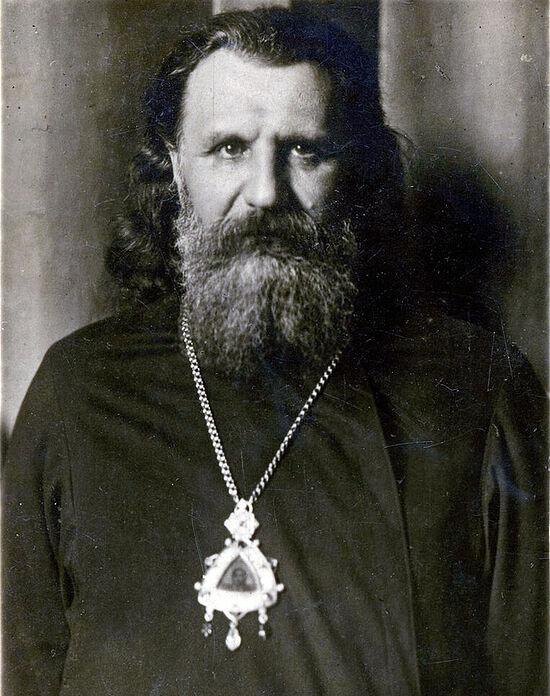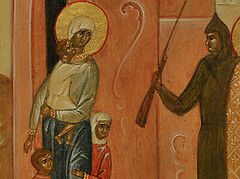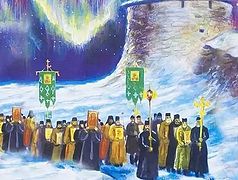On September 29/October 12 the Church honors the memory of the New Hieromartyr John (Pommer). It brings enormous joy to read his letters and sermons, to plunge into his radiant, fierce and mighty struggle while reading his scenes from his Life. How he could denounce, standing on the podium of the Latvian Saeima (Parliament)! It was impossible to resist him. But do we arm ourselves with the experience of our New Martyrs and Confessors? Do we pray to them for victory?
The first saint of Latvia… and all Russia
Janis Pommer, the future New Hieromartyr John of Riga (†1934), was born to a family of Orthodox Latvians. His great-grandfather, having been accused of embracing “the Russian faith,” was ridiculed by his opponents and was even denied burial at the (Lutheran) village cemetery after his death. Having consigned his body to the earth beyond the village fence, his loving fellow villagers made a mound and erected an eight-pointed Orthodox cross. The local authorities demolished that cross…
This was not the last time that the Orthodox Pommer family was persecuted for the Orthodox faith. Such were the circumstances the future hieromartyr and the first Latvian saint (there are no Catholic Latvian saints, and the Lutherans don’t recognize saints at all) grew up in.
For all his faithfulness to the Russian Church and personally to Patriarch Tikhon, St. John revealed the universal nature of Orthodoxy and the “power of the Cross” that raises it above ethnic feuds and Church schisms.
The future hieromartyr graduated from the Riga Seminary in Latvia and entered the Theological Academy in Kiev (Ukraine), where, with the blessing of St. John of Kronstadt (Russia), he was tonsured. He taught in Chernigov (again Ukraine), Vologda (Russia), Vilnius (Lithuania). Later he was consecrated as the Bishop of Slutsk, Vicar of the Diocese of Minsk (Belarus); then he carried out his archpastoral ministry in several Russian dioceses: those of Taganrog, Tver and Penza, where he put down the “Putyata schism,” in which the Soviet Government “polished” its tactics for the Renovationist Schism it later applied in an attempt to shatter Church unity across the country.
Priest Alexander Mazyrin, Ph.D in Church History, notes that the Church calendar calls this saint “St. John of Riga,” and that the service dedicated to him emphasizes the period of his ministry in Latvia. That is understandable, given that the service was composed in Latvia and we mustn’t depreciate his role as the first primate of the Latvian Church and the first Latvian saint. However, the toponyms “Riga” and “Latvia” are mentioned in the service dozens of times, while Penza (like Taganrog, Minsk and Tver) is mentioned just once. Meanwhile, according to Fr. Alexander, it was in Penza that St. John revealed himself as a Russian saint of national importance. The experience he received while opposing the split in Penza, orchestrated by the atheists and persecutors, later helped the entirety of the Russian Church combat the Renovationist schism.
St. John was the first to make a significant contribution to the struggle against this provocative phenomenon. In Fr. Alexander’s view, he is surely “St. John of Riga” as an archpastor, but as a hieromartyr he should be called “St. John of Penza.”
“Perhaps this should be reflected in the service as well,” Fr. Alexander continues. “Just as we give two titles to St. John (Maximovitch)—of Shanghai and San Francisco, though these two cities are very far apart and completely unrelated, perhaps it would be fair to call St. John (Pommer) ‘John of Penza and Riga.’”
The one from whom truth was not concealed from childhood became a saint
All the more today, as the Penza Metropolia is thoroughly studying the Penza period of St. John (Pommer)’s ministry, and many of the gaps have already been filled. Many aspects of the hieromartyr’s life have been researched by the current ruling hierarch, Metropolitan Seraphim (Domnin), along with Kira Georgievna Aristova, head of the Penza Metropolia’s legal department and Associate Professor of Penza State University.
 Metropolitan Seraphim of Penza and Nizhniy Lomov, holding the martyrology of those who suffered for their faith, “The Righteous Shall Live by Faith” By the way, in the Soviet era (when it was rather dangerous) Kira’s mother would receive parcels with Orthodox literature from the Holy Trinity Monastery in Jordanville: these were mainly copies of the Holy Scriptures, prayer books, books of akathists, and music… And in 1984, a year before Kira’s birth, a thin booklet on Hieromartyr John (Pommer) was among the books her mother receive. Later, when as a student of the History Department Kira was selecting a topic for her future thesis, she rummaged about in the piles of books at home and finally found that message from the Russian diaspora! That was providential…
Metropolitan Seraphim of Penza and Nizhniy Lomov, holding the martyrology of those who suffered for their faith, “The Righteous Shall Live by Faith” By the way, in the Soviet era (when it was rather dangerous) Kira’s mother would receive parcels with Orthodox literature from the Holy Trinity Monastery in Jordanville: these were mainly copies of the Holy Scriptures, prayer books, books of akathists, and music… And in 1984, a year before Kira’s birth, a thin booklet on Hieromartyr John (Pommer) was among the books her mother receive. Later, when as a student of the History Department Kira was selecting a topic for her future thesis, she rummaged about in the piles of books at home and finally found that message from the Russian diaspora! That was providential…
In Penza, there is also a community of local historians and researchers, headed by Alexander Igorevich Dvorzhansky and his colleague, Sergei Vladimirovich Zelev, who have for about twenty years worked on the Penza martyrology of those who suffered for the Christian faith. Their co-author, Archpriest Vladimir Klyuyev, who was once charged with the task of building a church of the New Martyrs, now serves as rector of the Patriarchal Metochion in honor of the Synaxis of the New Martyrs and Confessors of Russia in the Novokosino district of Moscow. A few years ago, their voluminous joint work entitled The Righteous Shall Live by Faith was published. Over 2,200 names were included in it. Their labors are carried on by young researchers of Penza State University and the Penza Theological Seminary.
The diocese offers a great deal of advice and methodological help to teachers who are developing lessons about the New Martyrs, along with stands, school museums, and parish expositions that children make with their own hands based on the photographs of their persecuted and martyred grandparents or facts from their family archives. Pilgrimage tours to sites associated with the memory of the New Martyrs of Penza and all of Russia are organized. Before the introduction of COVID-related restrictions were imposed, the young people of Penza would make pilgrimages to the Butovo Firing Range in Moscow.
Every adult can also find among the New Martyrs and Confessors someone who is close to him—someone with a similar profession, who lived in a neighboring street or in their native village. Even children, by the way, numbered among those tortured and murdered. At the Butovo Firing Range, even hungry children were executed by firing squad for petty thefts, such as stealing bread. And take the survived children of those who were executed and declared “enemies of the people”. What grief and mockery they faced!
The truth of his family’s persecution was not concealed from little Janis Pommer. In his young years he often caught it from his heterodox and atheist surroundings—and in the end, he became a saint…
The New Martyrs will not leave you unanswered
Such is the history of Russia in the twentieth century that every village, every family (even among those who fell away) can find somebody who in one way or another had the experience of the New Martyrs and Confessors, both revealed and unrevealed but known to God. Someone who at least helped them out of pity. It is known that he that receiveth a righteous man in the name of a righteous man shall receive a righteous man's reward (Mt. 10:41). It is so important to resurrect this vivifying link with history!
In Penza, Metropolitan Seraphim blesses all his parishioners not only to pray to the canonized local saints but also remember local martyrs for the faith, who were baptized or served in these parishes or belonged to these parishes at the Liturgy and the memorial services.
For example, the New Hieromartyr Paulinus (Kroshechkin; †1937) was born in Mokshan, the administrative center of the Mokshan district of the Penza region. When as a boy he fell seriously ill, his mother took him to Sarov, where he was healed and asked to be tonsured a monk. Afterwards he struggled in many celebrated monasteries and as a student of the Moscow Theological Academy ended up at Novospassky Monastery in Moscow, later becoming its father-superior. In due course he was consecrated as a bishop and headed a number of dioceses. While serving in the Diocese of Kursk he became close with the Glinsk elders. In 1994, when Schema-Archimandrite Guriy (Mishchenko; †2010; before the schema he bore the name Paulinus), who had taken the monastic vows at the Glinsk Hermitage Monastery and subsequently become known as “the Glinsk elder of Moscow,” ended up at Novospassky Monastery, he honored the memory of Hieromartyr Paulinus with gratitude. Fr. Guriy believed that it was through the hieromartyr’s prayers that he ended up at this monastery in the capital, which had been absorbing the traditions of the Glinsk elders. It is known that the spiritual father of Archbishop Alexei (Frolov; †2013), then abbot of Novospassky Monastery, was the Glinsk Elder Schema-Archimandrite Vitaly (Sidorenko; †1992). Is this not yet another proof of the New Martyrs’ participation in our lives?
It was St. Paulinus who proposed ending the Church schism after Patriarch Tikhon’s death by organizing new, secret Patriarchal elections from among the free and exiled bishops. He set about implementing all of that himself, for which he was first imprisoned and then sent into “honorary exile” to the Perm Diocese. Subsequently, he ended up in the Diocese of Kaluga where he met his future successor (a native of Penza, like him)—Hieromartyr Augustine (Belyayev; †1937), who was from St. John (Pommer)’s immediate circle. In 1936, Vladyka Paulinus was sentenced to ten years in the labor camps but was executed by a firing squad as early as 1937. Now in Mokshan, his birthplace, we annually commemorate him on his feast-day—October 21/November 3—the clergy and laity of the whole deanery and beyond gather for the festal service. An icon of the new martyr has been painted in Mokshan, and his short biography is distributed among all the parishioners and guests.
Novospassky Monastery in Moscow commemorates its former abbot too. What stops us from venerating our immediate ancestors in the faith?
What makes our contemporaries truly Orthodox?
For instance, Metropolitan Seraphim of Penza and Nizhniy Lomov was tonsured in honor of Hieromartyr Seraphim (Chichagov; †1937), who was shot at the Butovo Firing Range. Archpriest Kirill Kaleda, rector of the Churches of the Resurrection of Christ and the New Martyrs and Confessors of Russia in Butovo, once saw him slowly walking alone around the Butovo Firing Range.
“There are some hierarchs of the Russian Church who come here not only with official delegations!” Fr. Kirill once remarked.
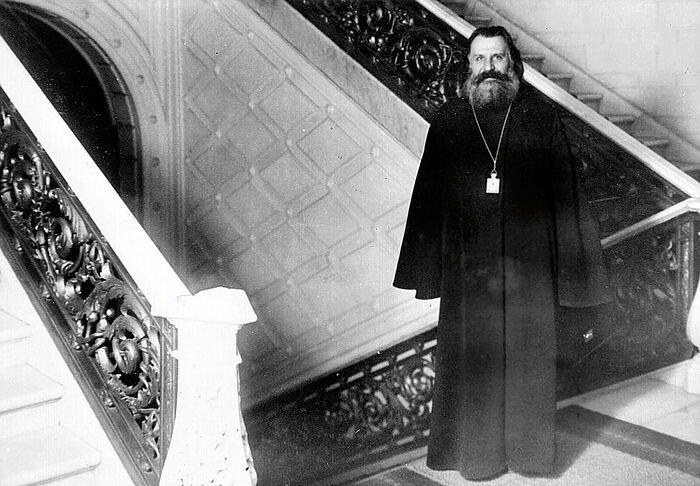 Archbishop John (Pommer) in the Latvian Seim
Archbishop John (Pommer) in the Latvian Seim
And the head of the Penza Metropolia is not the only Penza resident to bear the name of a new martyr, establishing a bond of prayer with our immediate ancestors in the faith. It has already become a custom here to tonsure monks in honor of the New Martyrs and Confessors. Thus, Hieromonk Thaddeus (Golosnykh), former editor-in-chief of the Vstrecha (“Meeting”) youth magazine of the Moscow Theological Academy, was tonsured in honor of Hieromartyr Thaddeus (Uspensky; †1937) of Tver. Hieromonk Augustine (Zaytsev) bears the name of Hieromartyr Augustine (Belyayev; †1937)—an archpastor who was included in the Synaxis of the New Martyrs of Penza. Nun Joanna (Kudryashova) was named in monasticism after Hieromartyr John (Pommer) himself.
Thus the well-known principle of St. Simeon the New Theologian is implemented:
“He who does not strive to attain union with one of the most recent saints with all love and a strong desire through a humble mind, but has developed a slight distrust of him will never be united and stand together with him in the same rank with the previous and earlier saints in any way, even if he believes he has all faith in and all love for God and all the saints. He will be rejected by them as one who has failed with the help of humility of mind to occupy the place that was ordained to him by God before the beginning of time.”
So it is in specifically in relation to the New Martyrs and Confessors of the Russian Church that the profound spiritual self-determination of our contemporaries is taking place.
 Schema-Archimandrite Gabriel (Bunge) at the Sretensky Seminary
Schema-Archimandrite Gabriel (Bunge) at the Sretensky Seminary
During his meetings at the Sretensky Theological Seminary (even before the building of the new Cathedral of the Resurrection of Christ and the New Martyrs and Confessors of Russia), Schema-Archimandrite Gabriel (Bunge), abbot of the Russian Orthodox Monastery of the Exaltation of the Cross near Lugano (Switzerland), would always emphasize that when it comes to faith, we should take into account that faith is not something individualistic; so we can’t say: “My God and I.” And, referring to St. John the Evangelist (cf. 1 Jn. 1:1-3), Fr. Gabriel noted that Christ’s favorite disciple wrote about the faith as about participation. It is only through Christ that we can be in contact with God the Father (cf. Jn. 14:6). The Apostles communicated with Christ directly, and the same is possible for us through participation in the Apostolic Church from generation to generation and through the experience of the recent saints who are close to us in terms of time and geography.
“Today Russia needs to find ways of participating in the experience of the New Martyrs and Confessors of the Russian Church,” Fr. Gabriel assures us. “You need to pray to them and venerate them—this is something that makes our contemporaries truly Orthodox.”
If the names of the New Martyrs were given not only to newly-tonsured monks but also to newborns and newly-baptized people, Russian society would witness to its faithfulness to God and the continuity of the standing for Christ by Russians. It is thanks to the podvig of the New Martyrs that now we can be Orthodox and even live in our own country in freedom.
We won the twentieth century! With the mightiest power in the whole universe
Many remember the corridor with the photographs of the New Martyrs at the first exposition in 2011, that opened a series of exhibitions, forums and ultimately—“Russia—My History” History Parks—which led to the interactive history of over 30,000 churches and monasteries (since restored or completely rebuilt) in 191 dioceses of the Russian Orthodox Church on six continents. People at St. Tikhon’s Orthodox University of the Humanities, which largely specializes in the New Martyrs, have observed the following rule: Once the name of another New Martyr has been discovered, news of the consecration of a new church or the restoration of an old one becomes known.
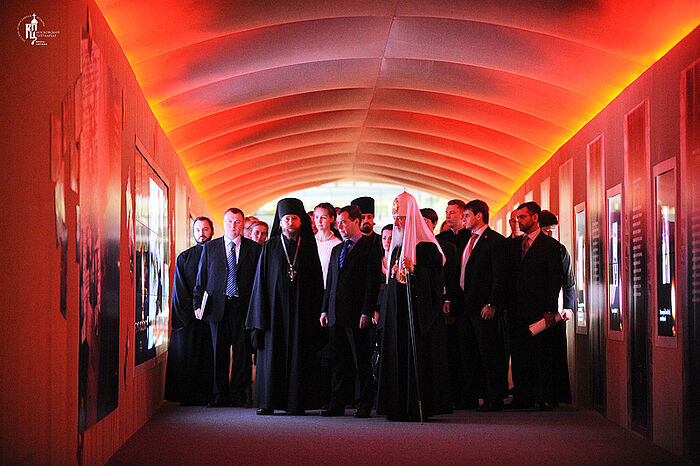 The memorial corridor of the Orthodox Rus’ 2011 exhibition that anticipated the development of the “Russia—My History” History Parks
The memorial corridor of the Orthodox Rus’ 2011 exhibition that anticipated the development of the “Russia—My History” History Parks
The New Martyrs and Confessors help us in our everyday struggle to this day. By the way, if St. John (Pommer) became the first Latvian saint, do any of us remember who became the first Russian saint, or saints? These were the holy Passion-Bearers Boris and Gleb, the millennium of whose martyrdom we marked not long ago. It is hard for our contemporaries to understand their podvig: “They allowed their brother to kill them. Who benefited from that?!” All of us did! Because those who chose to die physically rather than to renounce Christ and His commandments turned out to be more alive than anyone else and later helped St. Alexander Nevsky, their blood relative, win a victory over an enemy who greatly outnumbered him. In truth, his glorious feats of arms were popular and exciting even under the atheist regime, helping (as in our days) many boys and geown men convert to God.
 The archbishop’s summer residence where St. John (Pommer) was tortured and murdered
The archbishop’s summer residence where St. John (Pommer) was tortured and murdered
The Baptism of Rus’ by Prince Vladimir was not accompanied by a large number of deaths of martyrs for Christ, as was the case with the evangelization of other peoples. In the time of St. Alexander Nevsky there were only a handful of martyrs and passion-bearers. And now we have multitudes of the New Martyrs, both revealed and unrevealed and known to God alone.
“If only we prayed to the New Martyrs!” Schema-Archimandrite Iliy (Nozdrin) often exhorts us. “We pray to ancient saints, such as Great martyr Panteleimon, but they are far from us. But if we cried for help to the New Martyrs who are close and only waiting for our prayers, thousands would immediately answer our entreaties!”
The New Martyrs are bearers of a victorious experience and consciousness, and, having participated in their confession of faith, we learn to win against all the odds.
Alexander Solzhenitsyn believed that we had lost the twentieth century: Russia had lost so many people, so much strength and energy, while other nations were making progress… I can’t agree with him. At the very least because in the twentieth century we had Patriarch Tikhon and a host of the New Martyrs and Confessors of the Russian Church. The spiritual realm is mightier than this one. The New Martyrs are our main victory. And we won this victory with the mightiest power in the whole universe—the power of the Cross.
As St. John (Pommer) mocked at his persecutors in Penza who had attempted on his life: “I will be more frightening for you dead than alive!” And Metropolitan Joseph (Petrovykh; †1937) [by now canonized only by the ROCOR.—Trans.] of Petrograd, the champion of “the ecclesiology of the confession,” used to say: “The deaths of martyrs for the Church are a victory over violence and not a defeat.”
The saints unite us
Vladyka John returned to Latvia with the blessing of Patriarch Tikhon in the tough year of 1920 and headed the Latvian Church.
Here, in his native Latvia, where St. John served for the final fourteen years of his life and received the crown of martyrdom, he had to deal with far more ancient Church schisms—these were the Catholics and Lutherans who were fighting for churches and church property—consequences of the eleventh-century Great Schism and the sixteenth-century Reformation; there were also the Russian-speaking Old Believers who often sought his help and held him in high esteem—an echo of the seventeenth-century Russian Church schism. St. John’s terrible martyrdom—Vladyka was found burned alive, previously being tied during torture to a workbench with wire, with his severed limbs pierced all over to the bones with a soldering iron, and with his eyes put out—gathered everybody by his coffin. It was a true cross, exalted above all the divisions.
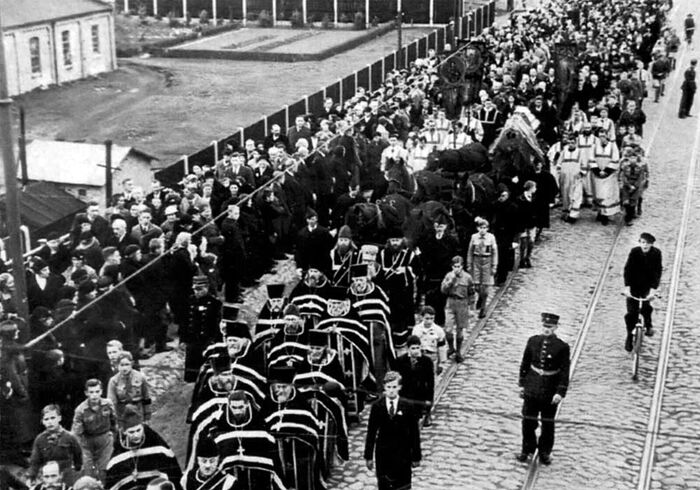 John (Pommer)’s funeral. Riga. October 21, 1934
John (Pommer)’s funeral. Riga. October 21, 1934
Another one of his misfortunes was the collapse of communications between the Latvian and the Russian nations, escalated by Russophobia. (Isn’t it being fomented again in once sister-republics today?) Then, in the early twentieth century, passions were being stirred up when Latvia had just regained its independence from Russia. The Latvian Orthodox Church lost its status as a legal entity and was robbed. Vladyka John who was more than once elected to the Latvian Seim secured the return of its official status.
Then the Latvian nationalists started pressing for autocephaly for the Latvian Church after its transfer to the jurisdiction of the Ecumenical Patriarchate:
“Tikhonites, submit to the voice of the universal judge [i.e., the Ecumenical Patriarch.—Auth.]! Leave your Tikhon, who has been removed by the Ecumenical Patriarch Gregory VII, and submit to the Holy Synod [i.e., the Renovationist one.—Auth.] of the Russian Orthodox Church, which has been recognized and approved by the Ecumenical Patriarch! Don’t you understand that your opposition to the Ecumenical Patriarchate plunges you into the chasm of the most pernicious schism from the rest of the universal Orthodox Church?” raved the lunatics. “Remember that Tikhon isn’t the head of the Orthodox Church—he is the leader of a sect that goes against the life and interests of the real Orthodox Church of Christ!”
Of course, Vladyka John, who sincerely loved his primate and was faithful to him, couldn’t tolerate such cynicism and take the side of the Patriarch of Constantinople who had disgraced himself by his association with the Renovationists (and even now, just as the hieromartyr foresaw, the confession of the Patriarchate of Constantinople does not shine with canonical Truth). Vladyka could feel those historical “stress lines”—where was truth and where lies twisted crookedly…
The saints unite us, while the henchmen of the devil are always trying to stir up discord and strife. Century after century, millennium after millennium they kill individual Christians, making an attempt on the Body of Christ—that is, the Church; but the Lord promised us that the gates of hell shall not prevail against it (Mt. 16:18).
People, don’t forget God!
While the circumstances of the murder of the first Latvian and our national Russian saint remain unknown, there is a version according to which he was slain by Latvian nationalists. By the way, nowadays their ideological heirs have financed the work of a “historian” who has devised the “Russian version” of St. John’s murder. The rewriting of history continues…
 The altar fresco of the Synaxis of the New Martyrs and Confessors of the Moscow Sretensky Monastery’s new cathedral
The altar fresco of the Synaxis of the New Martyrs and Confessors of the Moscow Sretensky Monastery’s new cathedral
All the more important for all of us to hold to Divine Truth and historical truth, and to honor the memory of those who laid down their lives and used their martyrs’ blood to seal and mend the breaks and splits in the Body of the Church and in the brotherhood of man.
Some years ago, a book entitled, The Bell on the Assembly Tower: The Life and Works of Hieromartyr John (Pommer), was published by the Moscow Sretensky Monastery’s Publishing House. This is what his contemporaries called him: “the bell on the assembly tower.” What was his alarm signal about? Among numerous other meanings, he witnessed to the Truth of the Resurrection.
When rabid nationalists labelled the Riga Cathedral as “a Russian boot”, and its ringing bells—as “a demonstration against Latvian Riga,” St. John would write to the slanderers in his throbbing ironic style:
“The meaning of Church bell ringing is so unambiguous and clear that even the worst enemies of Christianity—the Ottoman Turks—regarded it as a reminder of God. Not only sultans and mullahs but also janissaries and bashibazouks rose to the level of understanding of the idea of bell ringing in the Orthodox Church correctly. The gist of it is in the call: ‘People, don’t forget God!’”
Then there is no death. And the victory of our New Martyrs and Confessors is more real and greater than this world, where apostates, schismatics and atheists vainly, foolishly and unhappily plot against the eternal Church of Christ.

